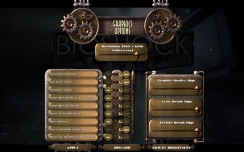BioShock
Publisher: 2K GamesBioShock is one of the best games to be released so far this year and is a ‘genetically enhanced’ first person shooter set in an underwater city called Rapture. The city was created at the bottom of the Atlantic Ocean by a man named Andrew Ryan as part of an ideological dream and is focused around a beautifully crafted 1930’s art-deco style.
2K Boston and 2K Australia have licensed and used Epic Games’ Unreal Engine 3 to great effect and have incorporated several DirectX 10 effects. These are all controlled via the ‘DirectX 10 Detail Surfaces’ option in the game’s graphics control panel.
As the game is based entirely under water, the developer has made great use of water shaders and, from what we have been told by 2K Games, there were two artists that worked only on making the water look truly stunning. The developers have used DirectX 10 to improve the water ripples when characters move through the water and there is massive use of pixel shaders to create wet-looking objects and surfaces.
Additionally, the DX10 version of the game uses the back depth buffer in order to create ‘soft’ particle effects; this is where the particle effects interact with their surroundings and overall look more realistic. There are other improvements to the game’s engine too – the developers have used DirectX 10’s DCF + texel offsets to improve shadow map filtering, which results in better-defined shadow edges.
As there is no in-built benchmarking utility, we have used FRAPS to record framerate over the course of three 90 second manual runthroughs in the Neptune's Bounty level. We averaged the three average frame rates recorded by FRAPS, but reported the median low framerate instead of the average in order to weed out the outliers. We set the image quality slider to ‘high’, leaving global lighting and Vsync disabled. Anisotropic filtering was set to 16x in the game’s configuration files and, currently, Unreal Engine 3 does not support anti-aliasing under DirectX 10 mode. However, Nvidia has told us that it is trying to remedy this problem with a driver update.
Interestingly in BioShock, the Radeon HD 3870 is quite a bit slower than the GeForce 8800 GT at 1680x1050, as the latter is right on the heels of its much more expensive sibling – the GeForce 8800 GTX. The performance deficit adds up to around 17 percent, but I honestly don’t believe you will be able to tell the difference between the two in a blind taste test. The reason I say this is because the frame rates are high (above 60 frames per second average and 30 fps minimum in both cases) enough for the difference to not be noticeable in anything but the benchmarks.
What makes this test scenario even more interesting is the fact that the Radeon HD 3870 actually makes up a lot of ground on the GeForce 8800 GT at 1920x1200 0xAA 16xAF to such an extent that the difference is just two frames per second, or less than five percent in relative terms. I can assure you that this definitely isn’t going to be a noticeable drop in performance.

MSI MPG Velox 100R Chassis Review
October 14 2021 | 15:04










Want to comment? Please log in.